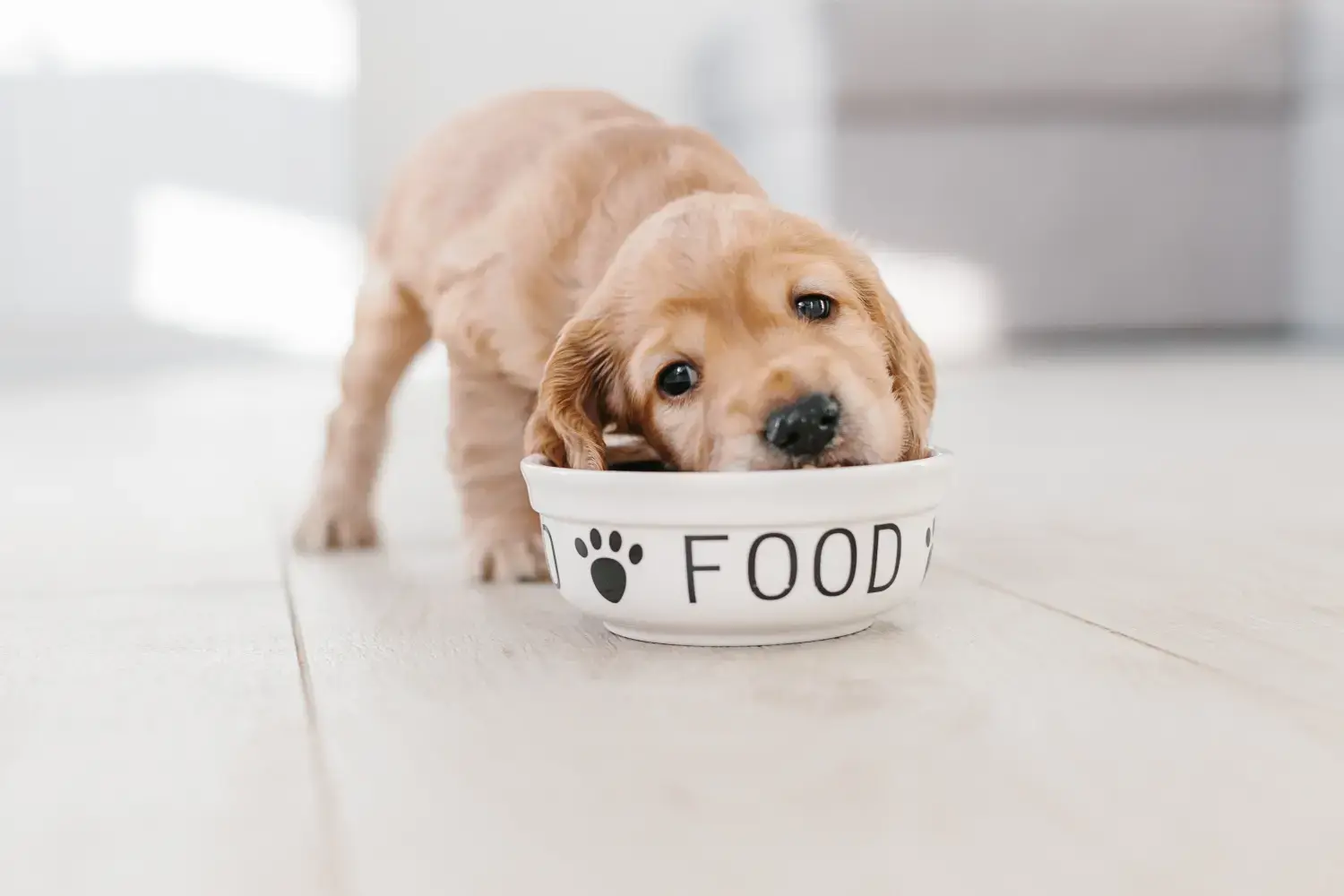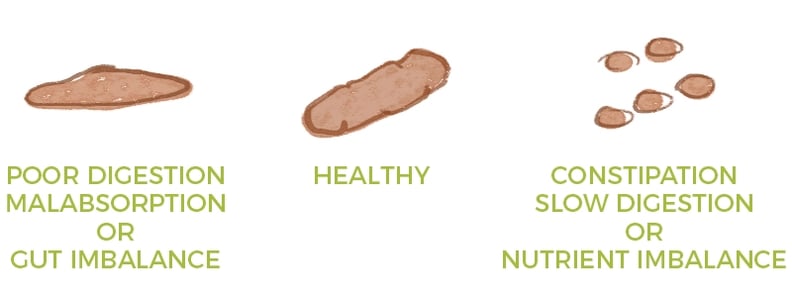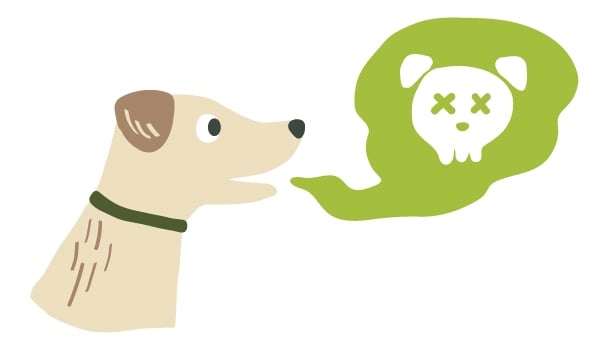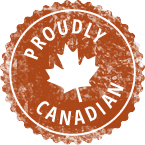
Caring for a growing puppy starts with a wholesome and balanced diet. But if you are stuck on the question - what should I feed my puppy? - then check out some of the most frequently asked puppy diet questions to help you make an informed decision.
When it comes to dog food, we often rely on brands to tell us what products are best for them. When you see a pet food with the word puppy plastered all over it, it’s easy to assume that this diet offers everything your puppy needs, but is that really the case?
What should I feed my puppy? Do puppies need to eat puppy food? How much food should I feed my puppy?
In this article, we answer all of these questions and more. Read on to get a quick rundown of puppy dietary requirements, some puppy feeding tips, and answers to some of the most asked questions about puppy food.
What Does My Puppy Need?

When choosing the right diet for your puppy, it's important to understand what nutrients puppies need to thrive.
While an average adult dog food will supply sufficient amounts of nutrients for most dogs, puppies have higher requirements for many nutrients during their growth and development stages.
Many of these nutrients are present in maintenance diets for adult dogs, but sometimes just not in the quantity needed to support growth and development.
Here are some of the key nutrients that high-quality puppy food should offer:
Brain Food for Puppies
The first nutrient that must be considered when feeding your puppy is omega 3 fatty acids, specifically EPA and DHA. EPA, eicosapentaenoic acid, and DHA, docosahexaenoic acid, are both types of omega 3 fatty acids that are vital to ensure proper cognitive development and health.
This means that they are necessary for brain development during the time in the puppy’s life that their brain is developing the most. While EPA and DHA are typically present in many dog foods, those levels are added to support the needs of adult dogs, not puppies. When to start feeding puppies food?
EPA and DHA can only be sourced abundantly from animal-based omega 3 sources, like fish oil.
To learn more about the benefits of omega 3 fatty acids check out this blog.
Skeletal Support for Puppies
The next nutrients that are required by your puppy for growth and development are Calcium and Phosphorus. Both of these minerals are the foundation of their skeletal system.
During the puppy stage, bones grow very quickly. Excesses and deficiencies can both lead to future skeletal problems and conditions, so having the right quantity of both is very important for puppies.
While it may seem appropriate to supply more calcium for puppies in growth stages, this needs to be done in moderation and must remain properly balanced with your puppy's phosphorus intake.
For most adult dogs, the ratio of calcium to phosphorus, according to AAFCO standards, is 1:1, but in puppies, that balance should be slightly altered to ~1.2-1.4:1. Phosphorus is abundantly sourced in meat, so meat-rich or high protein diets often require a higher calcium content to maintain an appropriate ratio.
Puppies Need More Calories Throughout the Day
While they are rapidly growing, puppies will require a higher-than-average caloric intake. It’s common for puppy formulas to be more calorie-dense or for more frequent meals to be fed to offer those additional calories throughout the day.
Where those calories are coming from is important, too. Calories should be sourced from meats and fats to help build muscle mass and to provide energy for the brain. Carbohydrates provide energy to the body for activity but do not need to be a significant source of the diet.
Foods with a moderate level of whole grains and/or low glycemic legumes will provide better energy than quick sugary ingredients like corn or rice.
Do I Have to Feed Puppy Food?
In nature, puppies eat what their mom eats, so why do we need separate formulas for adults and puppies when it comes to domesticated pets?
Technically no, you do not need to feed a food specifically marketed towards puppies. There are many types of diets that are suitable for any age dog, you just need to know what you are looking for.
Raw diets are often designed to meet the needs of all life stages. They mimic the natural diet of wolves and are highly digestible, offering a greater variety and quantity of nutrients than cooked commercial diets.
Cooked diets, like kibble, are formulated based on AFFCO nutrient profiles to meet the needs of individual life stages, so a food designed for an adult dog may be lacking in the extra nutrients your puppy will need.
For multi-pet households, it can get complicated to feed pets of different life stages separate foods. To help make mealtime easier, many kibble manufacturers have started to make all-life-stage diets.
Puppy Food Vs Adult Dog Food
You may wonder, "What is the difference between senior dog food and regular?" Similarly, puppy food is distinct from adult formulas in key ways. Puppy food is formulated to support growth, higher energy needs, and proper skeletal development. It contains higher levels of:
-
- Protein: To support muscle and tissue development.
- Calcium and Phosphorus: Essential for bone growth.
- Omega-3 Fatty Acids: For brain and vision development, particularly DHA.
How Much Should I Feed My Puppy?
Puppies need frequent meals due to their high metabolism and rapid growth. Younger puppies, under six months of age, often need three to four meals per day. By the time they’re six to twelve months old, you can reduce feedings to two to three meals per day. After a year, most dogs can transition to one or two meals a day, depending on their activity level.
The exact amount of food depends on their weight, breed, and activity level. For example:
-
- Smaller breeds often need smaller portions but more frequent meals.
- Medium breeds require moderate portions split into two to three meals.
- Large and giant breeds may require larger portions but can often be fed twice daily.
Monitoring your puppy’s weight and adjusting portions as they grow is essential. If you're asking, "How much food should a senior dog eat?", similar principles apply—portions should be tailored to their age, weight, and energy needs.
Feeding Puppies Without a Chart
Instead of relying solely on a feeding chart, focus on monitoring your puppy’s health. A thriving puppy will:
-
- Gain weight steadily but not excessively.
- Have a shiny coat and healthy skin.
- Be active and playful.
- Produce firm, well-formed stools.
Adjust feeding portions based on their activity levels and body condition. If your puppy seems lethargic or is gaining too much weight, reassess the food quality and portion size. Conversely, if they appear underweight, they may need additional calories or a nutrient-dense formula.
When Should I Switch My Puppy to Adult Food?
Knowing when to switch your dog to senior food is similar to understanding when to transition your puppy to adult food. This change typically happens between 9 months and 2 years of age, depending on the breed:
-
- Small breeds: Transition around 12 months.
- Medium breeds: Transition around 12-15 months.
- Large and giant breeds: Transition around 15-18 months.
Switching too early can deprive them of essential nutrients for growth while waiting too long can lead to excessive weight gain. Transition gradually over 7-10 days by mixing increasing amounts of adult food with the puppy food to avoid digestive upset.
What is an all-life stage dog food?
All-life-stage dog foods are designed to meet the nutritional needs of dogs at every stage of life. However, they may not be as precisely formulated for growth as puppy-specific diets. These foods are ideal for households with multiple dogs of different ages but must be portioned carefully for puppies to ensure they get enough calories and nutrients.
Feeding all life-stage foods isn’t an exact science, so monitoring your puppy's growth and development is vital. The best way to ensure your puppy is thriving is to observe their overall health:
-
- Weight: Puppies should gain weight steadily. Monitor their ribs and waistline; you should be able to feel ribs without seeing them.
- Coat and Skin: A shiny coat and smooth skin are signs of good nutrition. Dull, flaky skin may indicate a dietary deficiency.
- Energy Levels: Puppies should be energetic and curious. Lethargy or hyperactivity can indicate an imbalance in their diet.
- Stool Quality: Firm, well-formed stools are a sign of good digestion. Loose stools or excessive waste may suggest overfeeding or poor nutrient absorption.
Each puppy is unique, and their dietary needs may vary. You may need to add to or reduce feeding guidelines depending on their development and activity.
To learn more about how much amount of food to feed my dog, check out our dog food calculator in How Much Should I Feed My Dog?
Whether you choose puppy-specific food, an all-life-stage diet, or a raw or fresh food diet, ensure it meets their nutritional requirements. High-quality ingredients, proper portion control, and regular vet checkups are key to raising a healthy puppy.
As they grow, your puppy’s dietary needs will change. By providing them with the right food during their early stages, you set the foundation for a healthy and happy life.
What Happened to All the Puppy Food?

The last time you walked the aisles of your pet store, you may have noticed that many brands don’t even have puppy formulas. Lots of brands have adopted the all-life stage philosophy. Why is this?
Well, the first reason is for simplicity's sake, for both you, the consumer, and for the manufacturer. If they can make one food that serves the purpose of three, then why wouldn’t they? If you only need to buy one food for multiple dogs, then why not?
This strategy not only simplifies their products but also keeps costs down.
While this seems pretty straightforward, sadly, there are still many brands that are peddling sub-par foods, and with or without that ‘puppy’ tag, these foods are not going to work for every puppy.
Look at your ingredients and where the nutrients are coming from.
All foods, regardless of age, should be meat-rich and low-carb, with plenty of natural ingredients, like fruits and vegetables, in place of synthetic additives to meet minimum nutritional requirements.
To learn more, check out How to Read and Understand Pet Food Labels.
How Do I know if my puppy is on the right food?
Check Their Food
Take a look at their current food. The ingredient list should show at least two named meat sources as the first ingredients, followed by low-glycemic grains, legumes, or fruits and veggies.

Avoid refined or partial grains that offer fewer and less digestible nutrients, like white rice or oat hulls. An ingredient list that shows multiple parts of the same carb source is often a sign of ‘ingredient splitting’ to trick you into thinking there are fewer carbs in the food than it appears.
Foods that have very few real ingredients, and a long list of synthetic vitamin and mineral additives, are not going to provide enough usable nutrition for your puppy's growth stage.
Check Their Stool
What comes out of your puppy is a good indicator of what’s going on inside. Puppies often have sensitive stomachs as a result of their immature digestive systems. Bathroom habits can give the first warning sign that your puppy’s body is struggling and that you might need to make a change.
Keep a close watch on your puppy for signs of digestive distress. Take note of stool consistency to determine how well your dog is digesting their food. The stool should be firm and formed but not too hard.

If your puppy is straining to ‘go’, then something is not right. It could indicate constipation, slow digestion, or an inappropriate balance of nutrients like fibre, protein, or carbohydrates. Soft stool indicates poor digestion, malabsorption, or poor gut health.
Check out Dog Food for Sensitive Stomachs for more tips on dealing with digestion issues.
The frequency and size of stool can also tell you if your puppy is eating the right food.
If Lil’ Fido is producing large steamers every couple of hours, that indicates that his diet is lacking highly digestible proteins and may instead be filled with poorly digested ingredients, such as plant fibres (cellulose), animal by-products, or corn.
Poorly digested ingredients pass quickly through the digestive system without being properly processed. Excessive waste means that many of the nutrients in their food are not being utilized.
Another possible reason is that they are simply being overfed. This is quite common, as the feeding guidelines on your pet's food are relatively vague and should be adjusted to suit your puppy's breed and activity level.
Pets fed an appropriate, and nutritious diet should have regular, smaller stools that have a defined shape and are not overly soft or hard.
Oral Health
Everyone has experienced ‘puppy breath’, but the wrong type of food can make those nasty odours worse. Sugar and carb-heavy foods can feed bad breath-causing bacteria.

Kibble diets only provide minimal dental maintenance, so a dental health routine is recommended, even for puppies. Brushing your dog’s teeth regularly can reduce much of the harmful bacteria circulating in your dog's mouth and prevent that bacteria from affecting the rest of the body.
Raw dog food diets are ideal for dental health. The enzymes in raw meat actually help to reduce oral bacteria, much better than the dental effects of kibble diets.
To learn more about caring for your puppy's dental health, check out our Complete Pet Dental Guide.
Muscle Development
Puppies have a lot of growing to do in their first year, and if they are not provided with enough calories or the right nutrients, your pup will struggle to build muscle mass to support their bones and joints.
Inappropriate diets that limit muscle development can affect energy levels, further decreasing your dog's ability to build new muscle.
If you are concerned that your pooch is not building enough muscle, consider a higher protein diet and increasing activity levels.
Removing excessive carbs can also help. Amino acids are required to build muscle, and most plant proteins do not provide sufficient levels of essential amino acids. Meat-rich formulas will provide a fuller spectrum of amino acids and accommodate muscle development and growth.
Weight

Puppy bodies don’t always grow uniformly. Like babies, puppies can be a bit pudgy or even lanky and skinny at certain stages of their development. They may look a little funny, but it’s totally normal in most cases. Large dog breeds for example, often have exaggerated features like larger-than-life paws or ears down to the ground.
Many large breeds can get very tall and skinny in their first eight months and then build the bulk of their muscle mass in the last 4-8 months of their growth stages. We often see this in medium breeds like german shepherds and boxers, who can sometimes look underweight during growth stages.
On the other hand, some dogs are built to be stocky and muscular right from the start, like bulldogs and pugs.
A dog's weight can put a lot of strain on the skeletal system, and if they are consistently overfed during their important growth stages the extra weight can lead to skeletal issues like hip dysplasia and osteoarthritis, even in small breeds.
Monitoring your puppy's growth is important in preventing excessive weight gain.
Feel your dog for muscle development. Muscle is firmer than fat and should cover the skeletal system. Important areas include hind legs, shoulders, chest, neck, and flanks.
Weight gain without muscle development is a sign of excessive food intake, particularly quick-digesting carbohydrates, and low activity levels. For overweight puppies, high-protein, low-carb diets are recommended to boost metabolism and help reduce fatty deposits.
Ask yourself, Is My Dog Fat? If you are concerned, then you should adjust feeding guidelines and determine if the diet you are feeding is supplying the appropriate amount of protein, fat, and carbs.
Skin and Coat
Dull coats and flaky dry skin can be a sign that your pup is not getting enough fats, oils, and vitamins in its diet.
Fatty acids and antioxidants are used to help the body make new healthy tissue and heal damaged tissue. Diets lacking in these beneficial nutrients can leave the skin and coat looking dull, dry, and unhealthy.
Feeding a diet with natural sources of omega 3 and 6 fatty acids, like salmon oil, flaxseed oil, and kelp, as well as other nourishing fats, such as coconut oil, will condition the skin and coat, leaving it shiny and healthy-looking.
Antioxidants and vitamins from fresh fruits and vegetables provide protection and prevent or heal skin conditions by assisting in the production of healthy new cells.
These nutrient-dense ingredients will help rejuvenate your dog's skin and coat from the inside out.
Raw and fresh diets provide highly digestible nutrients to aid in skin and coat health. Try incorporating some raw or fresh ingredients into your puppy's existing diet. You may be pleasantly surprised by the results.
The Right Food For Your Puppy

You may need to try a few different foods before you find the right fit, and rotating animal proteins is a good way to provide the most balanced nutrition. Every protein has a different nutrient profile, and regularly swapping between a few different foods will provide the benefits of all of them.
Always transition your puppy slowly, over the course of at least a week, to minimize digestive distress. Expect some changes to stool quality during any transition, and monitor and track your pet’s bowel movements during food changes.
As your puppy grows and develops, its weight, size, eating habits, bathroom habits, and energy levels are going to fluctuate. Don’t be alarmed if a dietary change sparks some of these age-related developments, as they will settle down once your puppy has been fully transitioned.
Whether you are finding a solution to a problem or just looking to improve your puppy's quality of life, look to their diet for answers.
Frequently Asked Questions
What should I feed my puppy?
Puppies should be fed high-quality puppy-specific dog food that provides essential nutrients for their growth and development.
How often should I feed my puppy?
Puppies usually need to be fed multiple times a day. Follow the feeding guidelines on the dog food label or consult your veterinarian.
Can I feed my puppy human food?
While some human foods are safe for puppies in moderation, it's best to stick to balanced puppy food to ensure they receive the right nutrition. Avoid feeding them foods that can be harmful, like chocolate and onions.
When should I transition my puppy to adult dog food?
The timing of this transition varies by breed, but it typically occurs between 9 months to 2 years of age, depending on breed and size. Consult your veterinarian for guidance on the best time for your specific puppy.
Should I feed my puppy wet or dry dog food?
Both wet and dry dog food can be suitable for puppies. Some owners prefer a combination of both for variety but choose high-quality products designed for puppies to ensure proper nutrition.
Can I give my puppy treats, and how many is too many?
You can give your puppy treats. Ideally, you should use treats during training as positive reinforcement.
.png?width=200&height=66&name=logo%20(1).png)




.jpg)

